The Sani Pass is an iconic mountain pass in South Africa. It is the holy grail of 4×4 drives, following 8km of rocky, gravel road that snakes down the Drakensberg Mountains.
Driving the Sani Pass, South Africa, to Lesotho or the reverse, requires grit and a degree of competence. It is not for the weakhearted and must be undertaken in a 4×4 vehicle.
Our exciting cross-country Lesotho road trip would culminate with a self-drive descent of the Sani pass in our 4×4 Toyota Hilux. We had bought the Hilux in South Africa, and it was already suitable for camping and off-road adventures.
Since arriving in South Africa, my dream of conquering this challenge has finally become a reality. Pitting myself and my machine against a formidable adversary like the Sani Pass promised an epic showdown.
This 4×4 self-drive adventure was just one of many we completed across South Africa and other Southern African countries.
Essential Info for Driving Sani Pass
Planning to tackle the legendary Sani Pass? Here’s what you need to know before taking on this thrilling 4×4 adventure between South Africa and Lesotho:
- ⛰️ Elevation & Distance – The pass climbs from 1,544m to 2,876m over just 8 km of steep, twisting gravel road through the Drakensberg Mountains. The full Sani Pass route spans 94 km between Underberg (South Africa) and Mokhotlong (Lesotho).
- ⏳ Drive Time – The steepest section takes around 2 hours one way, depending on weather and road conditions. If you’re driving the full route, plan for at least 3.5 hours total.
- 🚙 4×4 Required – Only proper 4×4 vehicles are allowed. This is no place for a standard SUV!
- 🛂 Border Crossings – You’ll need your passport to clear both South African and Lesotho border posts.
- ⛈️ Weather Warnings – Sani Pass is open year-round but can close suddenly due to heavy rain, snow, or fog—making it even more challenging (as we found out!).
Thinking of driving it? Check conditions first, and get ready for one of the most epic (and possibly nerve-wracking) drives of your life! 😅
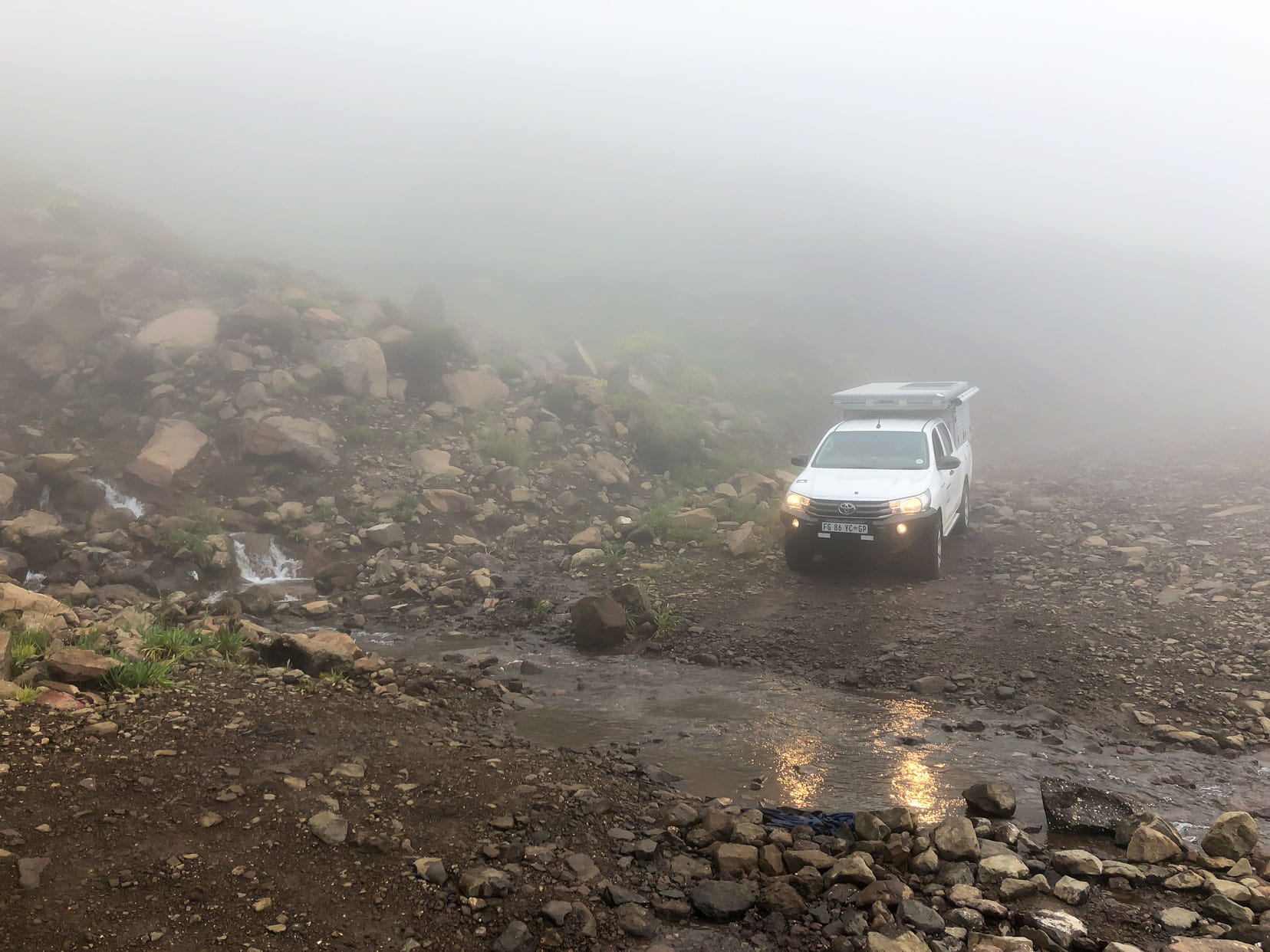
To help you plan your Sani Pass adventure, we have included the following:
Map – Sani Pass between South Africa and Lesotho
How to Use This Sani Pass Route Map
- To use this interactive map effectively, click the square icon in the upper right corner to expand.
- A key will appear on the left, guiding you through various locations.
- A yellow marker (🟡) indicates accommodation options.
- A green marker (🟢) indicates a campsite.
- A pink marker (🔴) indicates border control.
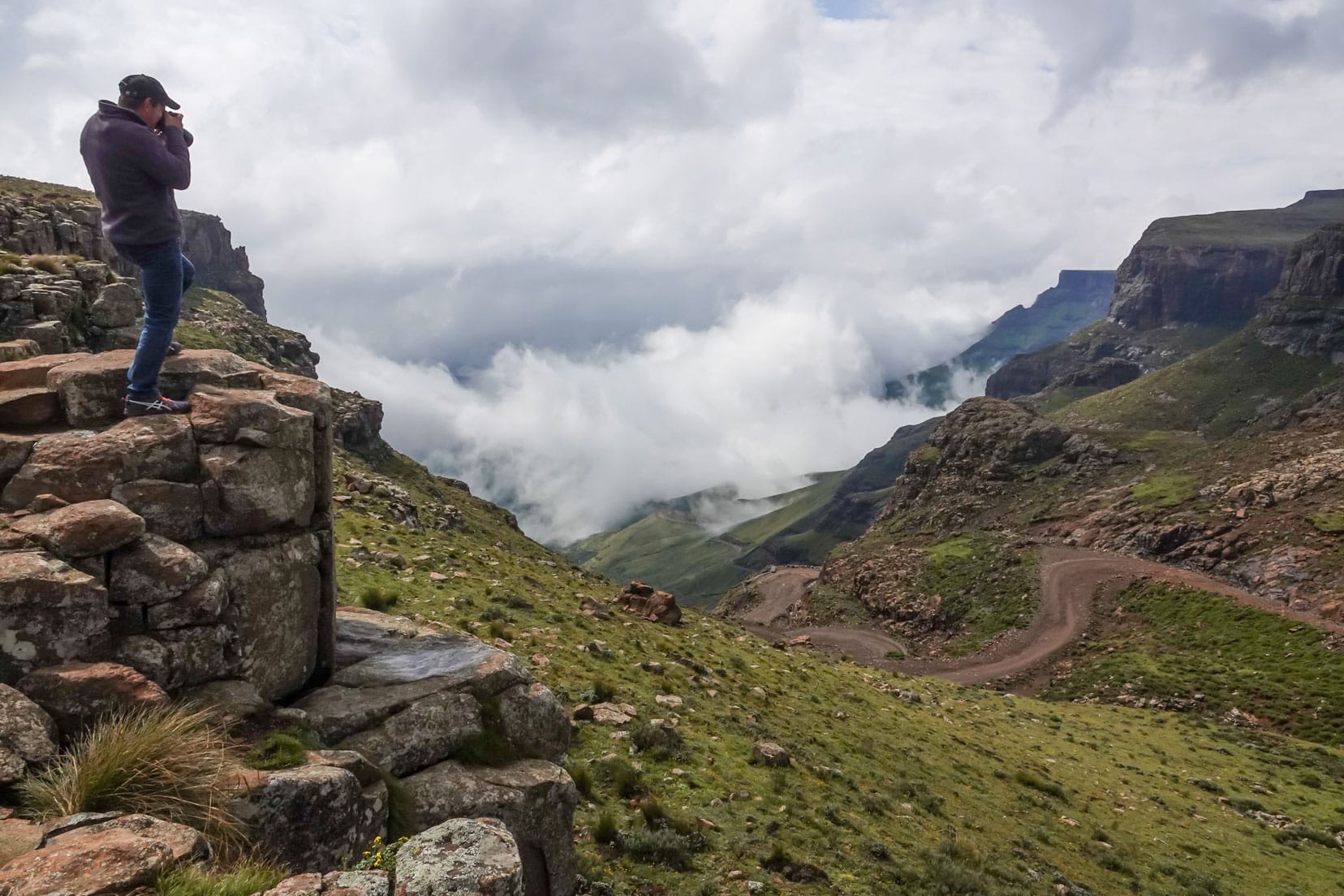
Video: Our Sani Pass Self Drive 4×4 Descent ( From Start to Finish)
This footage covers the drive from the top of the Sani Pass, starting at Lesotho border control down to the exit at South Africa border control. The footage has been sped up (x8).
It provides a fair idea of what you can expect on this Sani Pass 4×4 drive.
Book A Tour or Self-Drive? You Choose What’s Right For You
Whether you prefer the ease of a guided tour or the thrill of a self-drive adventure, exploring the Sani Pass offers unforgettable experiences tailored to every traveller’s comfort level.
🚙 Book a Personal Tour to the Sani Pass
If a 4×4 self-drive of the Sani Pass is not your thing, then that’s absolutely fine. You can still have the full experience without the stress of being behind the wheel by joining a personal tour of Sani Pass.
Let an experienced driver make the right decisions while you sit back and enjoy the panoramas. You still get the bragging rights, you know.
Some tour companies allow you to drive your own 4×4 in a tag-along tour under the guidance of a guide for that extra peace of mind.
🚙 Self-Drive the Sani Pass – Without Your Own Vehicle
For many considering a 4×4 traverse of the Sani Pass without your own vehicle, you’ll need to hire a 4×4. As mentioned, we bought our 4×4 in South Africa so we could take the slow road and overland Africa, which is much more affordable than hiring a vehicle.
We’ve personally used Discover Cars quite a few times. They offer value for money and a hassle-free hire which is really important when you’re a budget traveller and careful with your pennies.
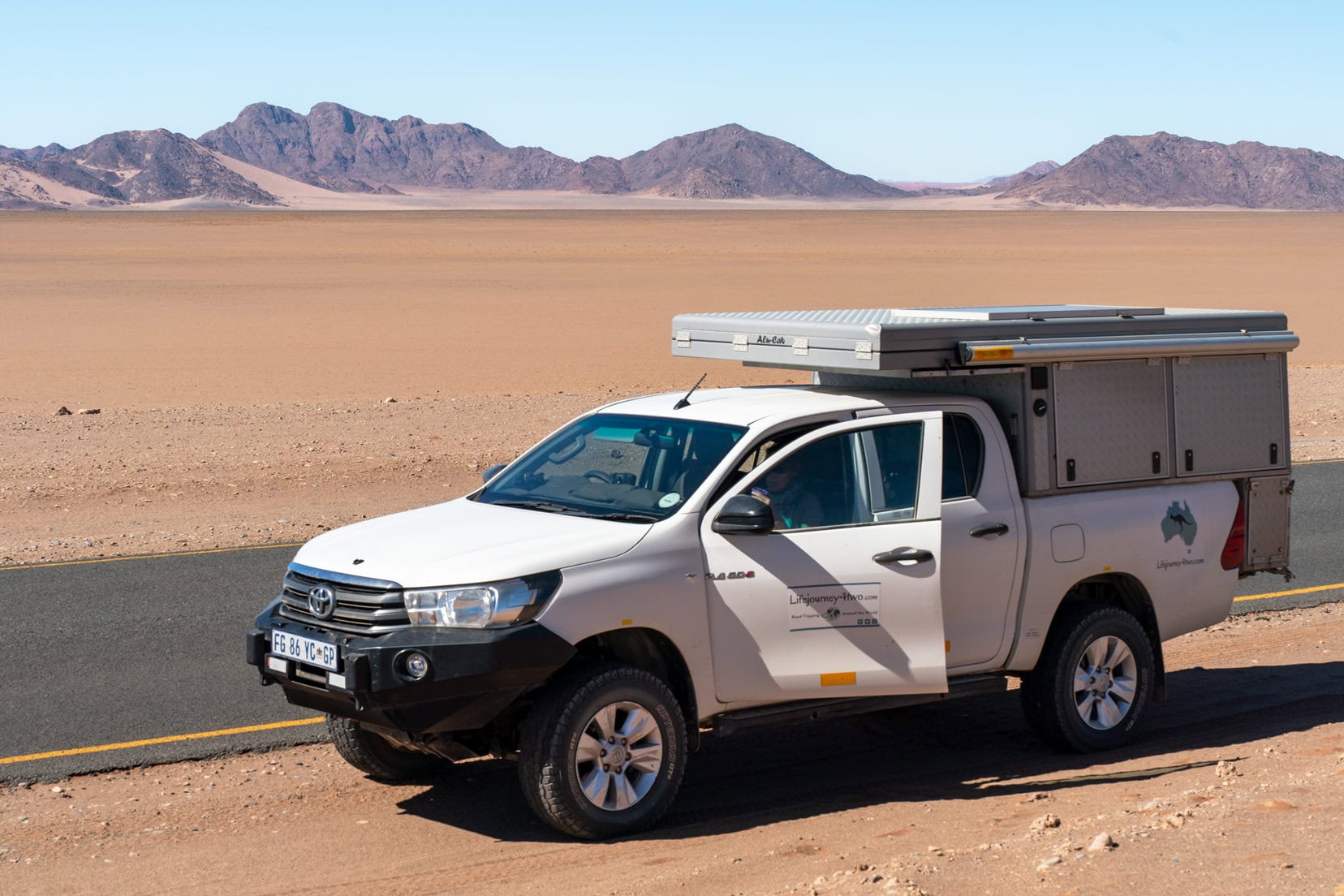
🚘 If you are looking to hire a car, then we recommend DiscoverCars.
- They are winners of the World’s Best Car Rental Booking Website
- They have a Price Match Guarantee.
- 4.5 Rating on Trustpilot
- Free Cancellation
How to Plan a Sani Pass 4×4 Drive – Essential Info
Behind the scenes of a successful road trip is thorough planning. Trust me, it’s something you get good at when you do it all the time; that’s us after more than 7 years on the road.
Here are considerations that you need to account for:
Plan for the Weather
April to September are generally dry, with minimal rain and sub-zero winter conditions that can bring snow and ice. Only attempt a winter drive if your vehicle and driving skills are suited for snowy conditions; otherwise, reconsider.
October to March marks the wet season, characterized by washouts, deep ruts, and streams. Temperatures peak in the mid-to-high 30s Degrees C, and nights are mild. The safest times to travel are at the beginning or end of these periods.
Remember, border control may close access to the Sani Pass during severe weather, so always check the forecast using apps like YR, WeatherSmart, and Windy.
Passport and Sani Pass border requirements
At the South Africa border control, you are stamped out of the country and then stamped in at the Lesotho border control—or vice versa if you are driving the opposite way.
To enter Lesotho, you must pay a small cash fee for road tax (between ZAR 40 and 80, depending on vehicle weight). No payment is required at South African border control.
Lesotho border control opening times: 08:00 a.m. to 04:00 p.m.
South Africa border control opening times: 08:00 a.m. to 06:00 p.m.
Entry visa: Some passports are eligible for visa-free entry into Lesotho for up to 14 days. Check eligibility here.
Vehicle Preparation
Besides the obvious maintenance, quick things you can check on the vehicle are good-condition ‘All Terrain’ tyres, a spare wheel or even two, tools to change a wheel, and an air compressor to inflate the tyres. Wiper blades and lights should be fit for purpose.
Navigation
In South Africa, Google Maps travel times should not be relied on when driving 4×4 roads. Tracks4Africa maps include realistic driving times. We have and trust the Tracks4Africa digital and hard-copy maps.
Travel Time
A one-way trip from border post to border post averages 2 hours, dependent on weather and track conditions.
Sani Pass distance
The one-way driving distance between the Lesotho and South African border control offices is 8 kilometres.
Attractions
At the Sani Pass summit, visit the Sani Mountain Lodge, which claims the title of the ‘highest pub in Africa.’ Walk the grounds of the Sani Mountain Lodge for views down onto the gravel road that winds up the Sani Pass.
What to Wear
Lesotho, the mountain kingdom, is subject to variable seasonal temperatures. Layering your clothing is your best bet. Depending on your travel season, you must account for snow and showers. Sturdy hiking shoes are advised.
Onward Journey
If you start your drive to the Sani Pass from South Africa, you may want to explore Lesotho before returning. If so, you’ll want to read this Lesotho road trip article.
Mobile Network
Lesotho’s largest network provider is Vodacom. If you use South Africa’s Vodacom network (we were), it will not be recognised by Lesotho’s Vodacom network. You will need to buy a local Vodacom SIM card or use the free wi-fi at the Sani Mountain Lodge.
Overnight accommodation at Sani Pass, Lesotho
There are four accommodation options. Three are in-house options (Sani Mountain Lodge, Masoba-Soba Lodge and Sani Stone Lodge), and the fourth is camping at Sani Top Backpackers campsite, which is what we chose. Refer to the map.
Overnight accommodation near Underberg, South Africa
There are many options to suit any budget. However, one with great reviews (8.3/10 rating) is Sani Lodge and Backpackers Sani Pass South Africa.
It’s closer to Sani Pass than Underberg, only 23km from the Sani Pass South Africa border control. ✅ You can check out the reviews here.
Planning a Trip to South Africa?
- 🚗 Hiring a car? We recommend getting a quote from DiscoverCars
- 🚐 Hiring a campervan? We recommend Motorhome Republic
- ⛑ Arranged your travel insurance? Compare quotes from World Nomads & Safetywing
- 🪪 Order your International Driver’s Licence online here
- 🏩 Booked your accommodation? We use Booking.com to find the best deals
- 🐾 Is someone pet-sitting for you? 🐾 We use and love TrustedHousesitters
- (Get 25% off at checkout for new memberships with our discount code: LIFEJOURNEY25)
Our Experience: Driving the 4×4 Sani Pass Lesotho to South Africa
Transitioning from the planning to the actual drive, the Sani Pass proved to be every bit of the adventure we anticipated. Here are the gritty details of our experience on this phenomenal route.
Sani Pass Summit – Arrival
It was mid-February, and we had entered Lesotho via the Caledonspoort Border Control, spending two days crossing the country via Katse Dam. You can read more about our self-drive Lesotho road trip here.
We drove the last few kilometres to the Sani Pass summit in super-thick fog. I was travelling at 20km/hr on the main road, so I was not only concerned about what I could not see in front but also about being rear-ended.
Spying the sign to the Sani Mountain Lodge, we turned off the road and inched our vehicle into the carpark.
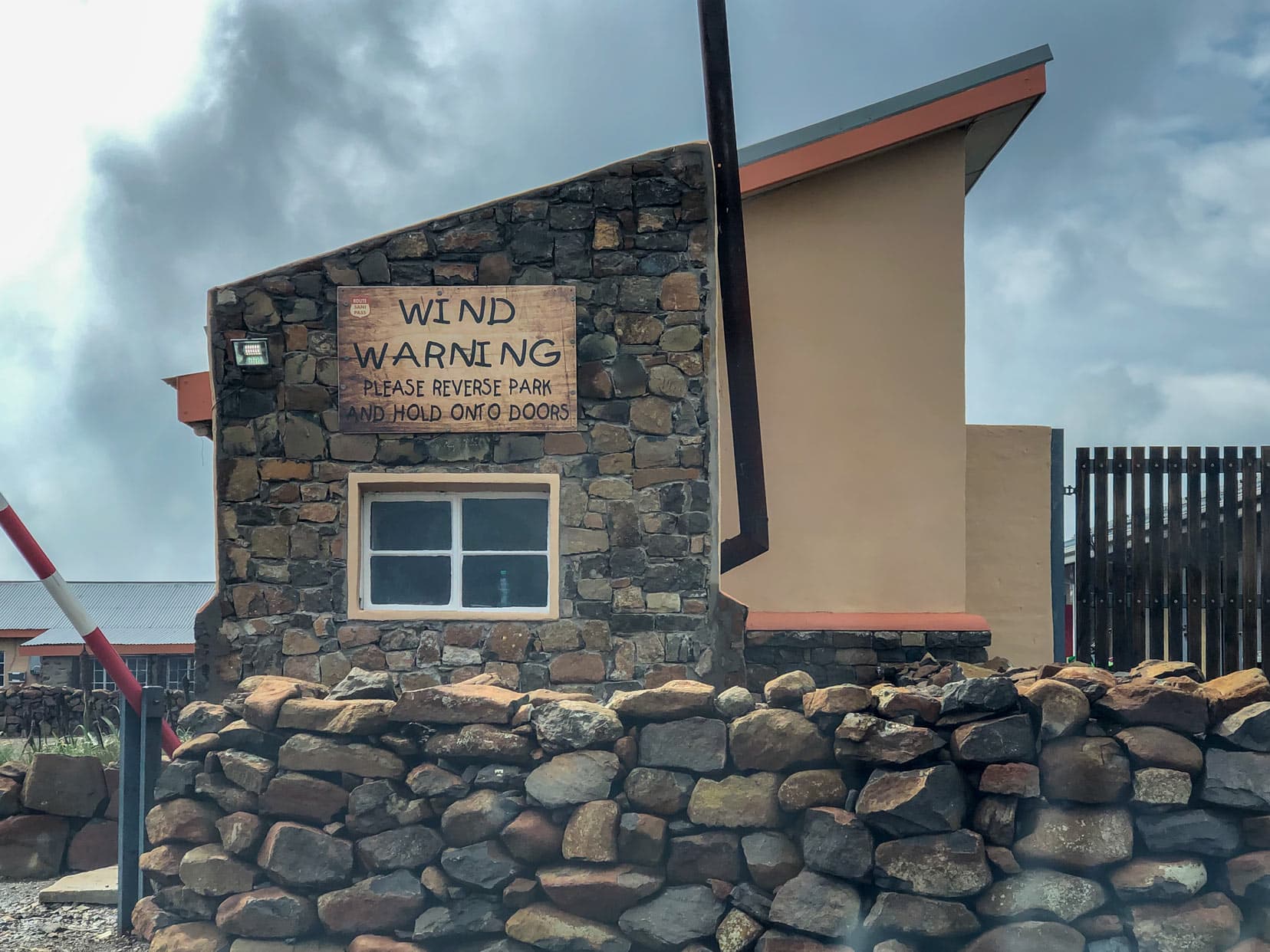
The Highest Pub in Africa
Not only does the Sani Mountain Lodge manage the campsite bookings and payment for the Sani Tops Backpackers campsite, but it also claims the title of having the highest pub in Africa.
During our check-in, we asked the Sani Mountain Lodge reception staff whether they thought the fog might lift by morning. They looked incredulous, but they said that the fog was quite normal at this time of year (February) and could last all day. Say what?
Now, that response was totally unexpected. Well, the weather was out of our control so we’d have to see what the next day would bring.
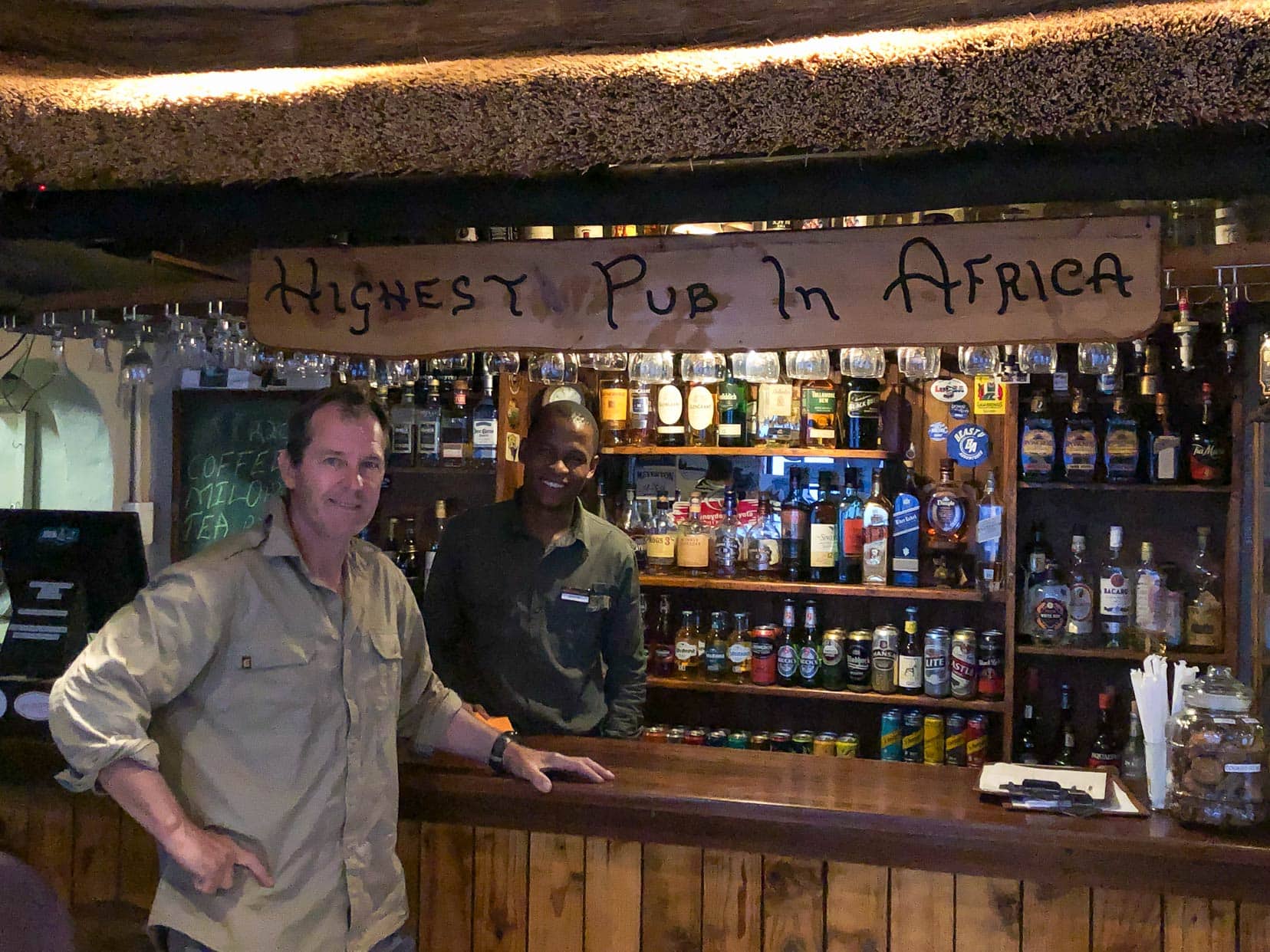
In the meantime, we made our way into the bar area of the Highest Pub in Africa, ordered a drink and grabbed the obligatory photo. We hadn’t bothered buying a local SIM card when entering Lesotho, so now we could enjoy the free wifi.
It had been a long day, so I took the super-slow foggy drive from the Lodge to the campsite, 300m away. At times, I had Shelley out walking with a torch as the fog was impenetrable to our headlights and rocks marking the track’s edges were invisible obstacles.
D-Day: Sani Pass Descent
The following morning, we were rested and ready to leave Lesotho, start the drive to the Sani Pass, and re-enter South Africa. Looking from our campsite, the previous night’s fog had lifted, but not completely. It still lingered, looking ominous.
We drove to the Sani Mountain Lodge carpark and walked to the open area in front to survey our intended route. It was the perfect spot to see the gravel road snaking up the Sani Pass, the distant section shrouded in fog.
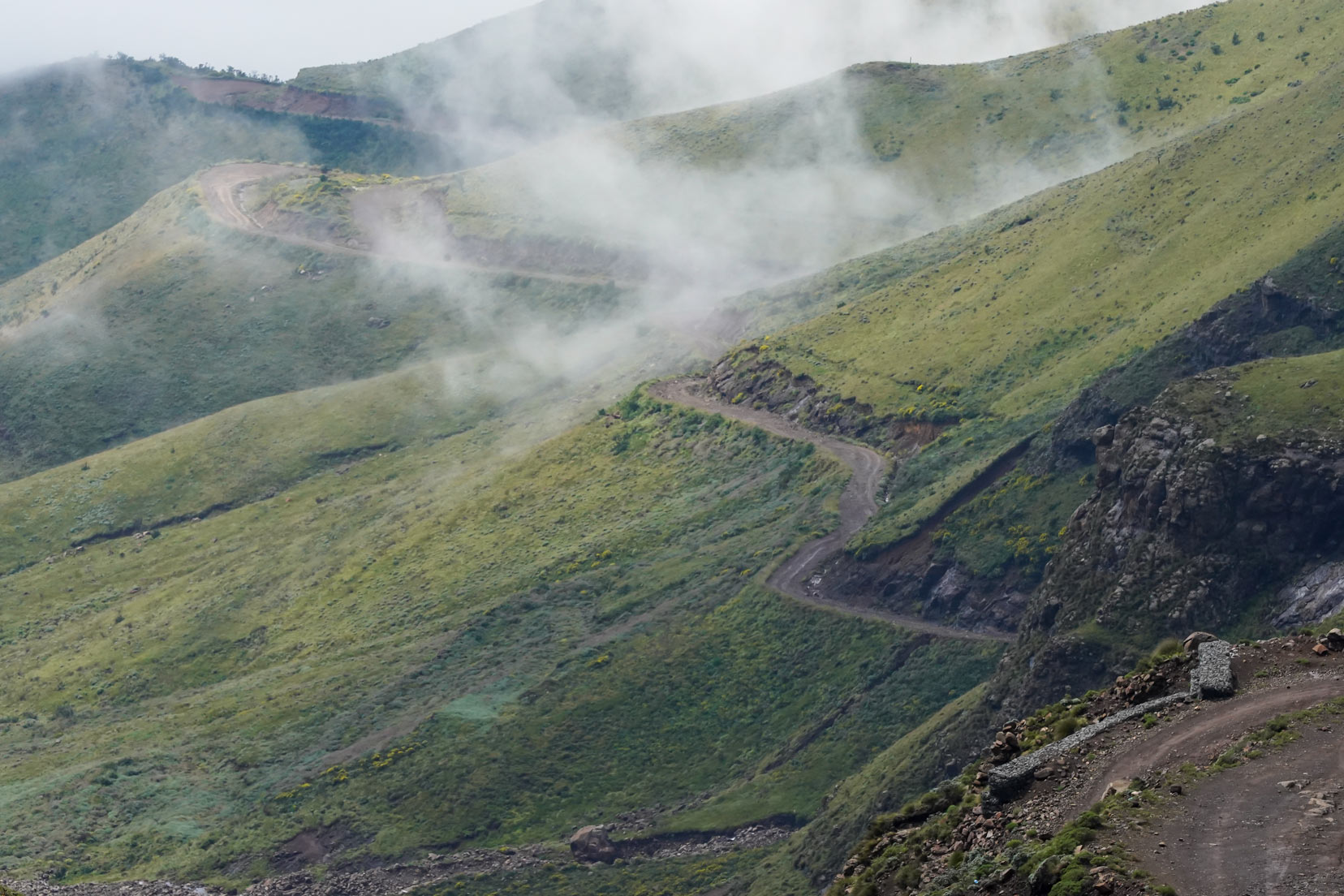
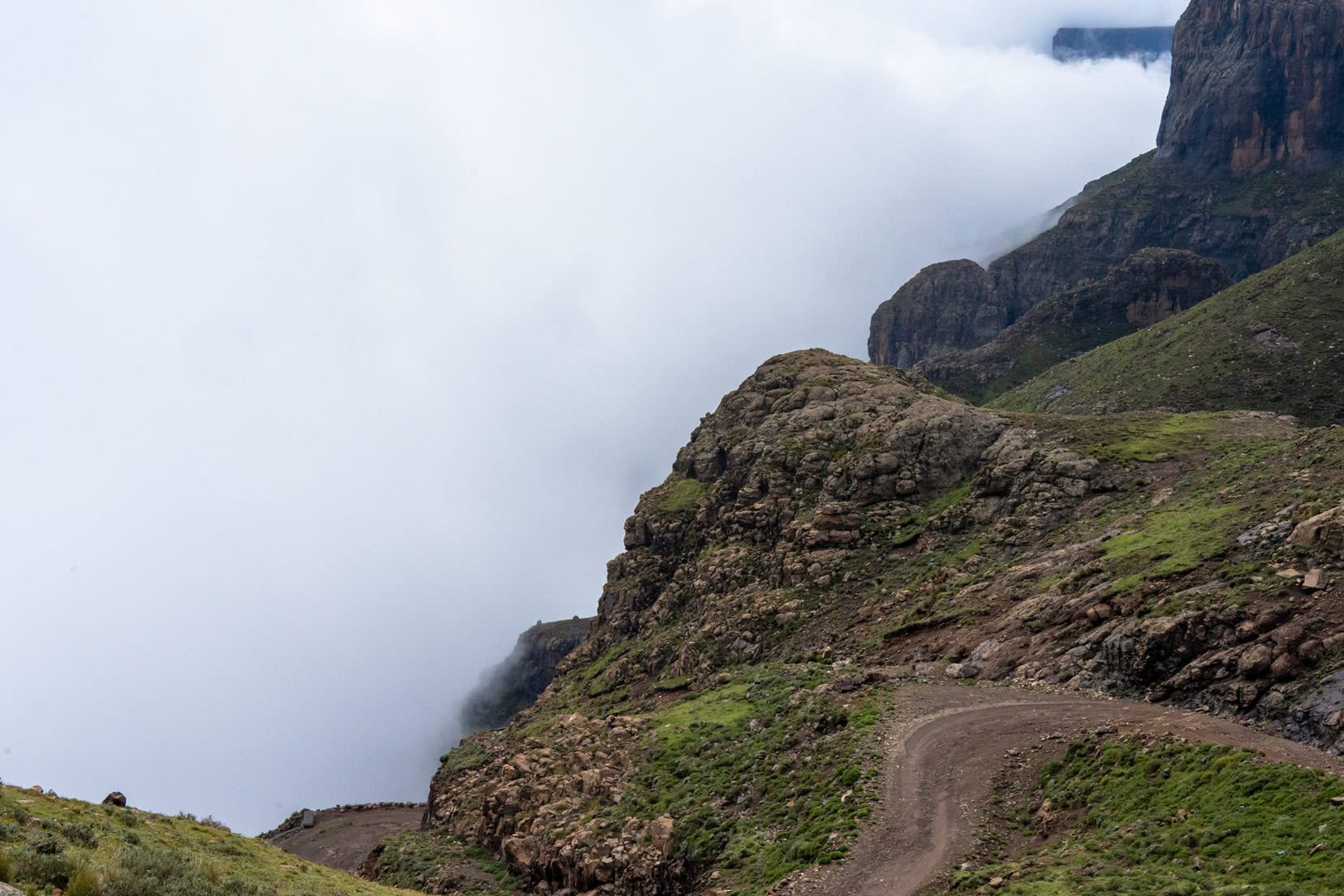
Even as we were watching, we could see waves of fog ascending and quickly filling the open areas of the pass. This didn’t bode well.
(❗️Note: Since our visit, you now pay to park at the lodge. However, keep your receipt and show it in the pub, where you get that price off your bill if you purchase food or drinks.)
Delayed Start: Sani Pass Drive On Hold
Expecting rain later that morning, we decided to leave immediately to make the most of the daylight, unsure of the drive duration or road conditions. The fog was descending en masse.
Looking for the Lesotho Border Control office, we spied a Stop sign and stopped the vehicle. There was no one here manning this point to check if you had your passport stamped.
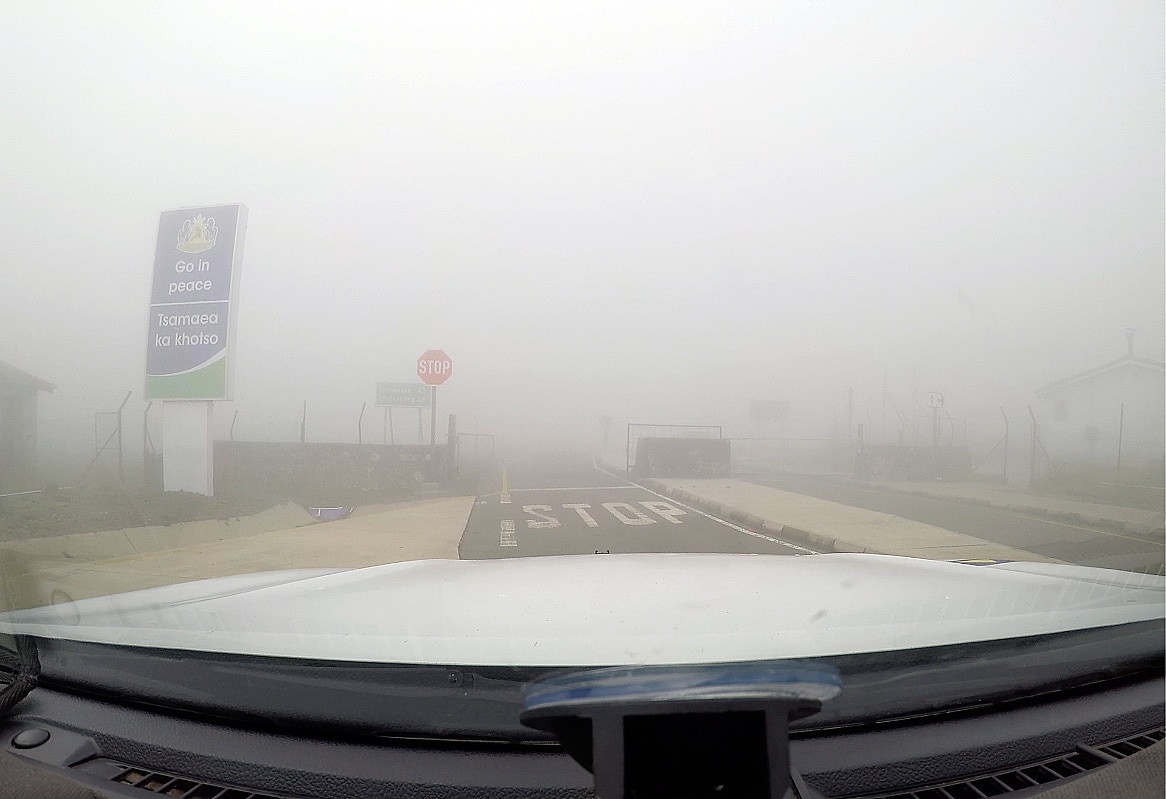
We looked hard for the Lesotho Border Control immigration office but could not see it due to thick fog. Luckily, a 4×4 taxi van pulled in behind us, and the passengers alighted to make their way to a nearby small corrugated iron building.
Ahh, there it is. I followed and joined the queue. Soon, both of us were stamped out of Lesotho. I was expecting to be asked if I was driving a 4×4, but this was not the case.
We returned to our vehicle and drove 100m further past the stop sign onto gravel in ‘no man’s land’, between the two border posts. However, the heavy fog was too thick and pulled over to wait.
Several local 4×4 taxi vans passed by, but I was patient, preferring to wait for the fog to thin and visibility to improve. This was not to be.
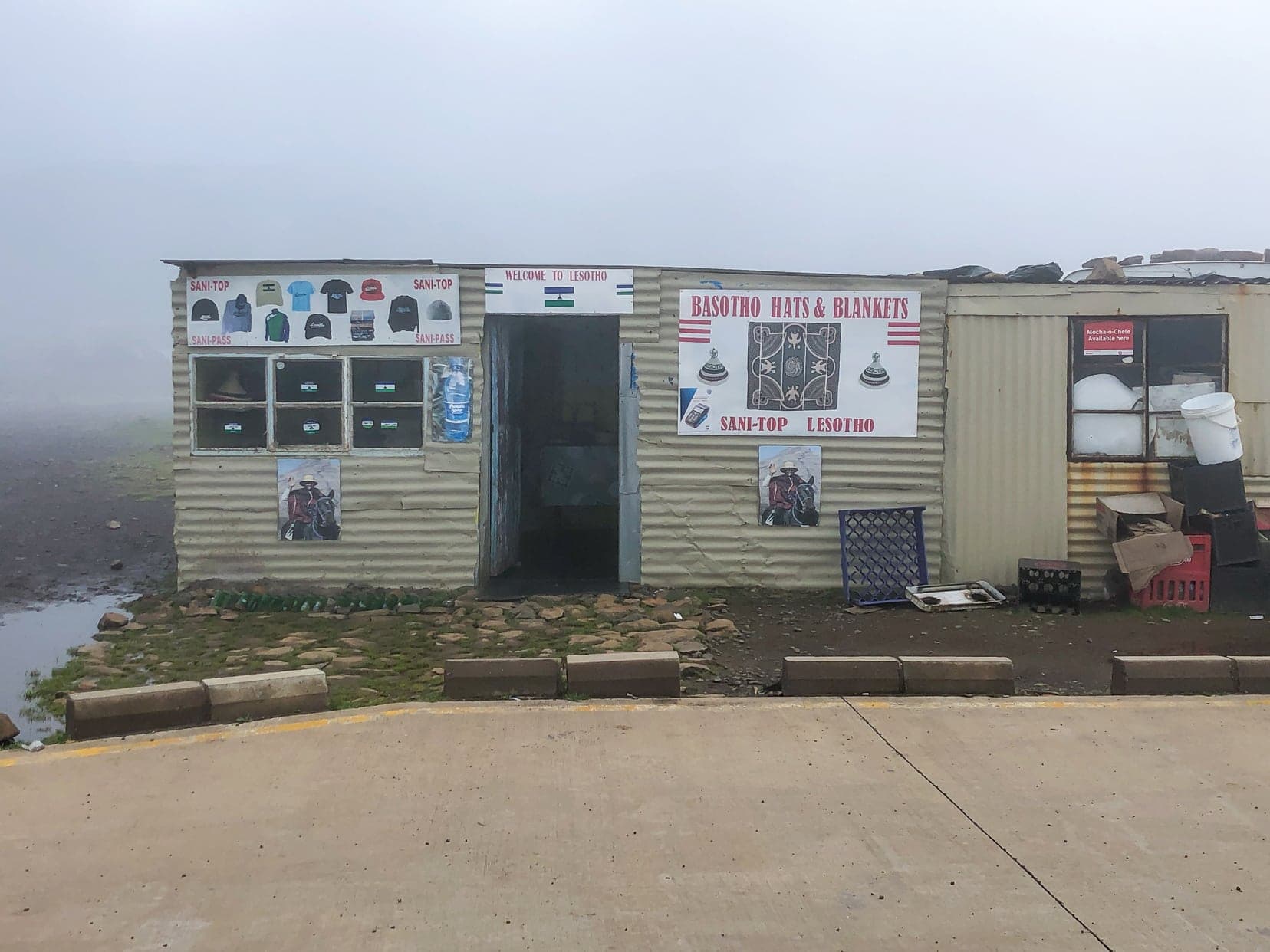
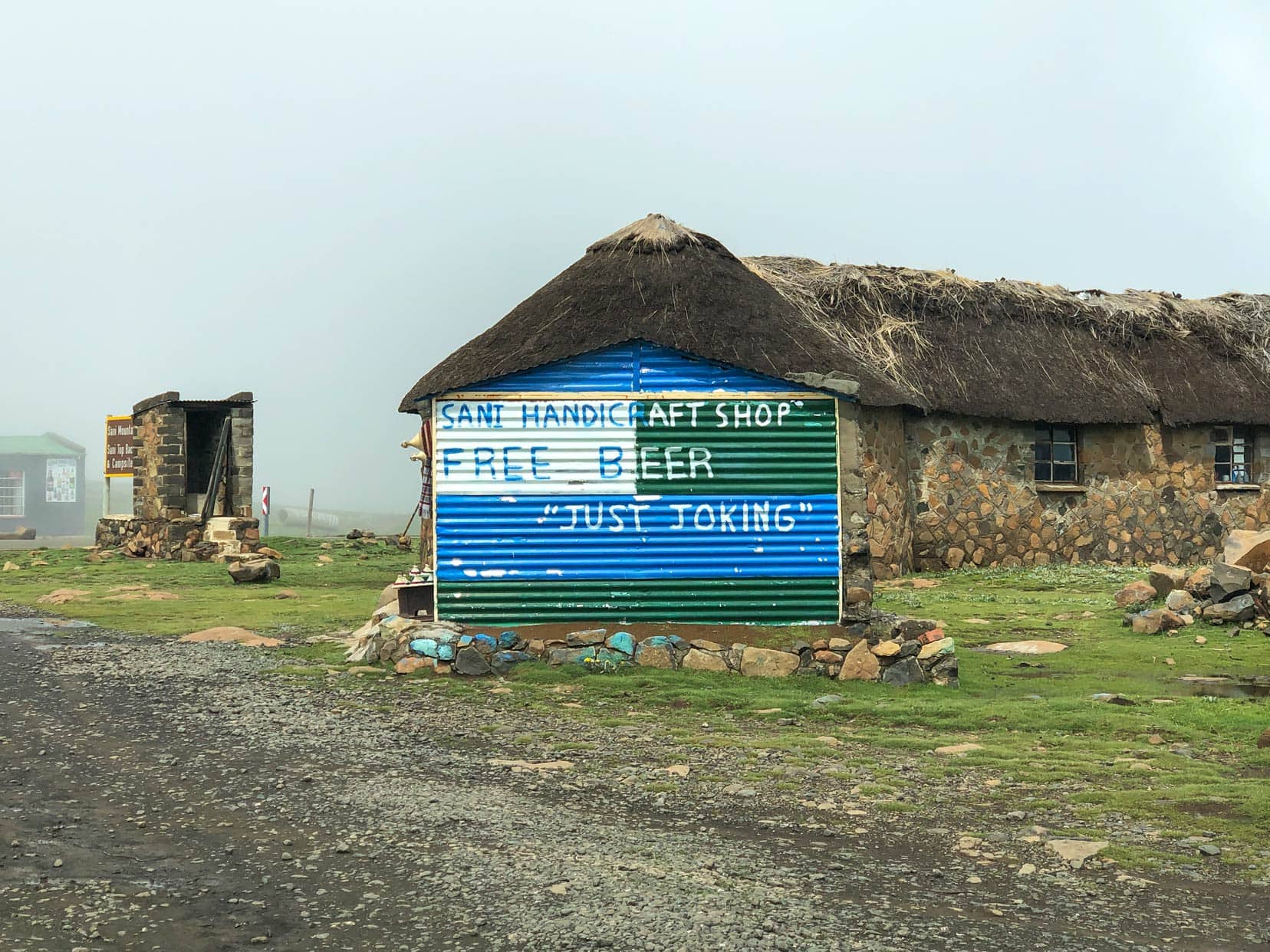
Follow the Leader: Sani Pass Descent Underway
Some 20 minutes later, one of the Lesotho-plated Toyota Hi-Ace 4×4 passenger vans passed us by to start the Sani Pass descent. I was told afterwards that these passenger vans are modified with new engines and a 4×4 transmission so far from stock standard.
Shelley and I looked at each other and agreed that following one of the locals would surely be a smart move. We considered this the best bet in the fog, so engaged 4×4 Low and played follow the leader.
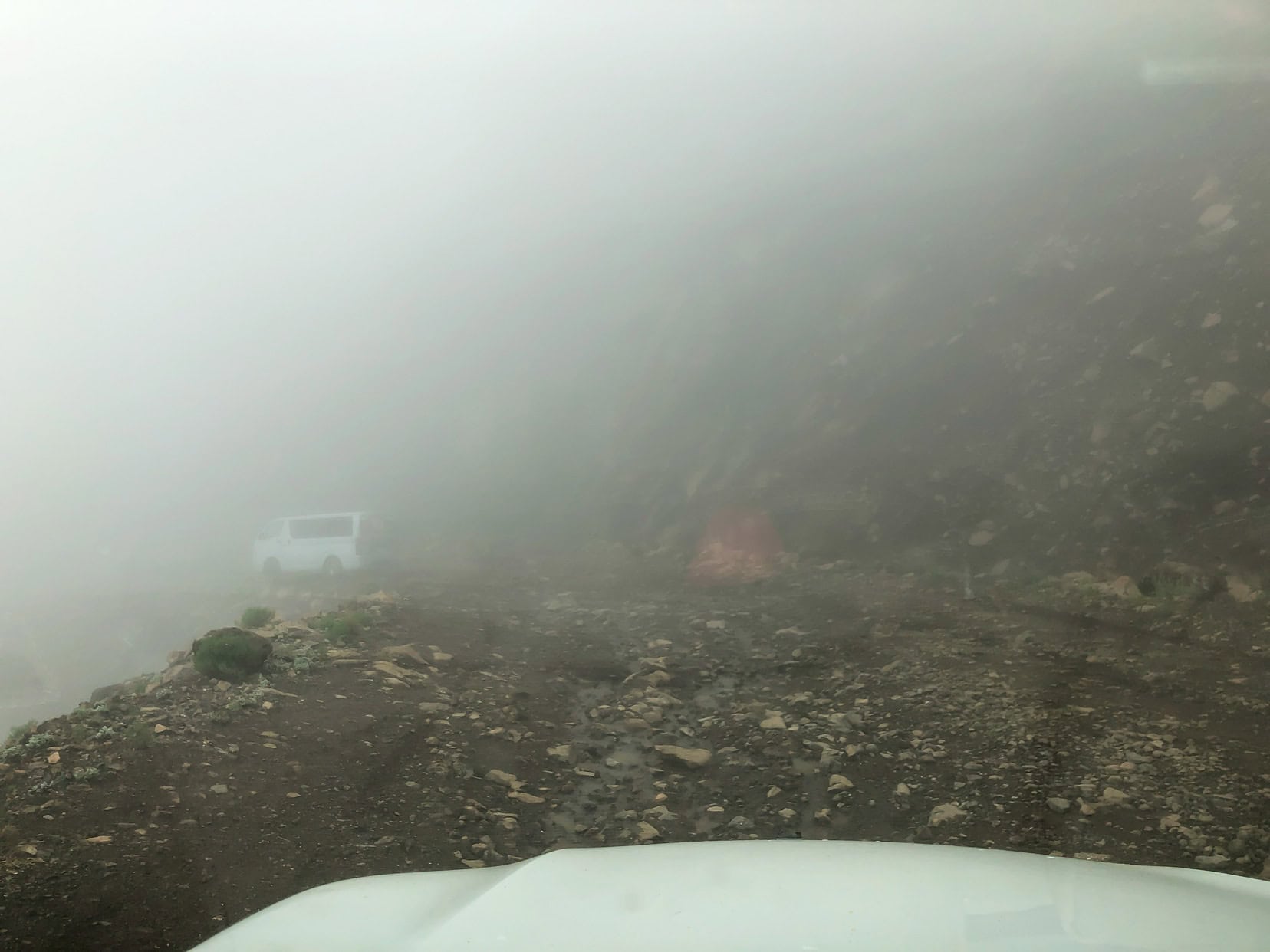
The initial descent from the summit was to be the steepest of the drive. The switchbacks are within the first kilometre and need to be driven slowly.
The track width is about 1.5 car widths, so I needed to pull to the side to allow the oncoming uphill traffic to pass by. Shelley, in the passenger seat, was closest to the precipice and was very worried, but because it was foggy, you could not see the extent of the drop.
I always kept my outer tyres at least 0.5m from the edge.
Full Focus
The track was strewn with stones, some small and some larger. However, following the tracks of previous vehicles provide the best driving line. Maneuvering around the switchbacks may require stopping partway and reversing to get a better line.

It depends on your vehicle’s turning circle and the driving line you pick when entering the turn. I reversed a couple of times after I couldn’t negotiate the turn on full-lock.
It had begun to rain, so there was also the odd tyre spin on the wet stones to contend with in reverse, but it was no big deal. In these early sections, slow and steady is definitely the name of the game.
Many bends were deeply rutted caused by the channelling of water, an additional hazard.
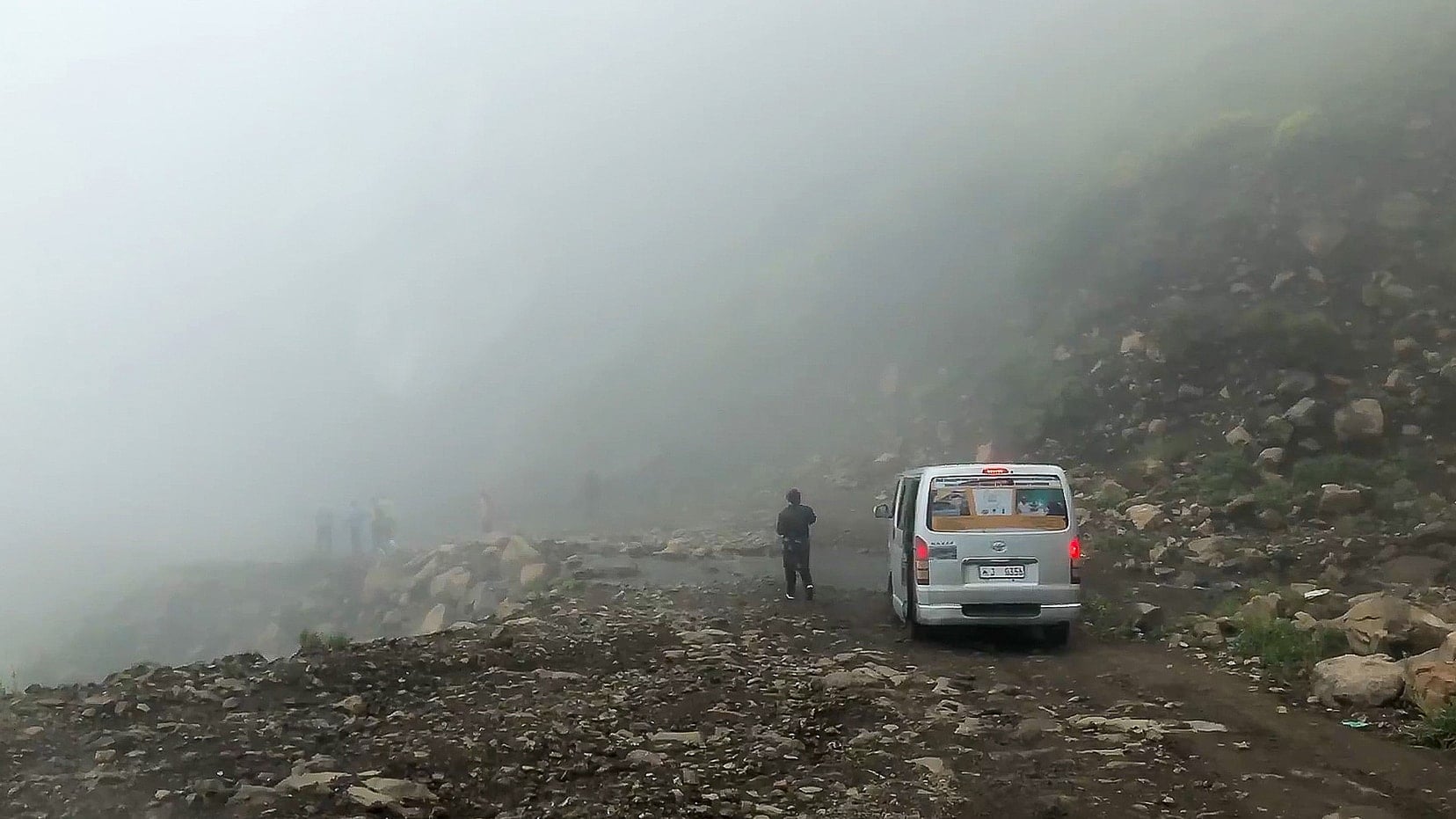
During the descent, before crossing the streams, we would see the van’s passengers leave the vehicle and cross on foot while the van drove through the water. We guessed this was to improve the vehicle’s ground clearance, not an issue with our vehicle’s raised suspension.
At this point, I thought that if a passenger van could drive the Sani Pass with 9 adult passengers, it would surely be doable for us.
No Stopping
It sometimes worked out that when vehicles were head to head, the driver with the best opportunity to pull to the side would do so. Normally, you would expect the uphill vehicle to have the right of way, but this method worked well.
We crossed a few slow-running streams at a few inches of depth. However, I could well imagine that these could quickly deepen during periods of heavy rain.
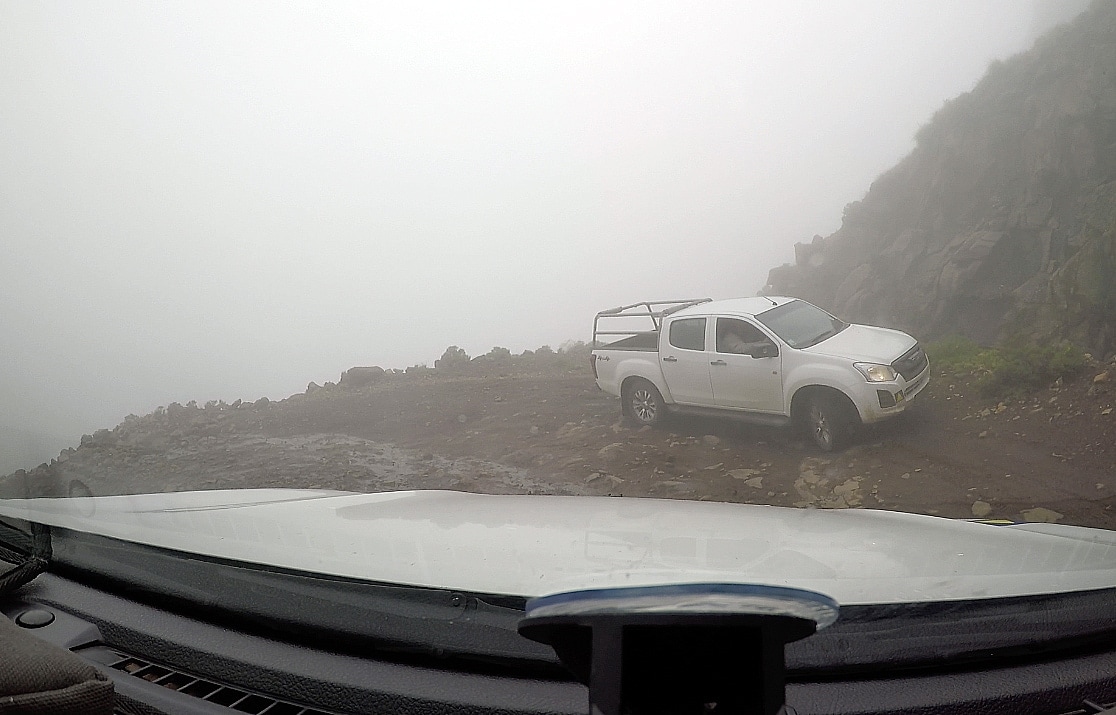
I didn’t have any time to admire the limited views being fully focused on the drive. With the steep inclines and switchbacks behind us, the track had begun to flatten out.
I stopped to engage 4×4 High, still keeping my speed on the slow side. The track widened.
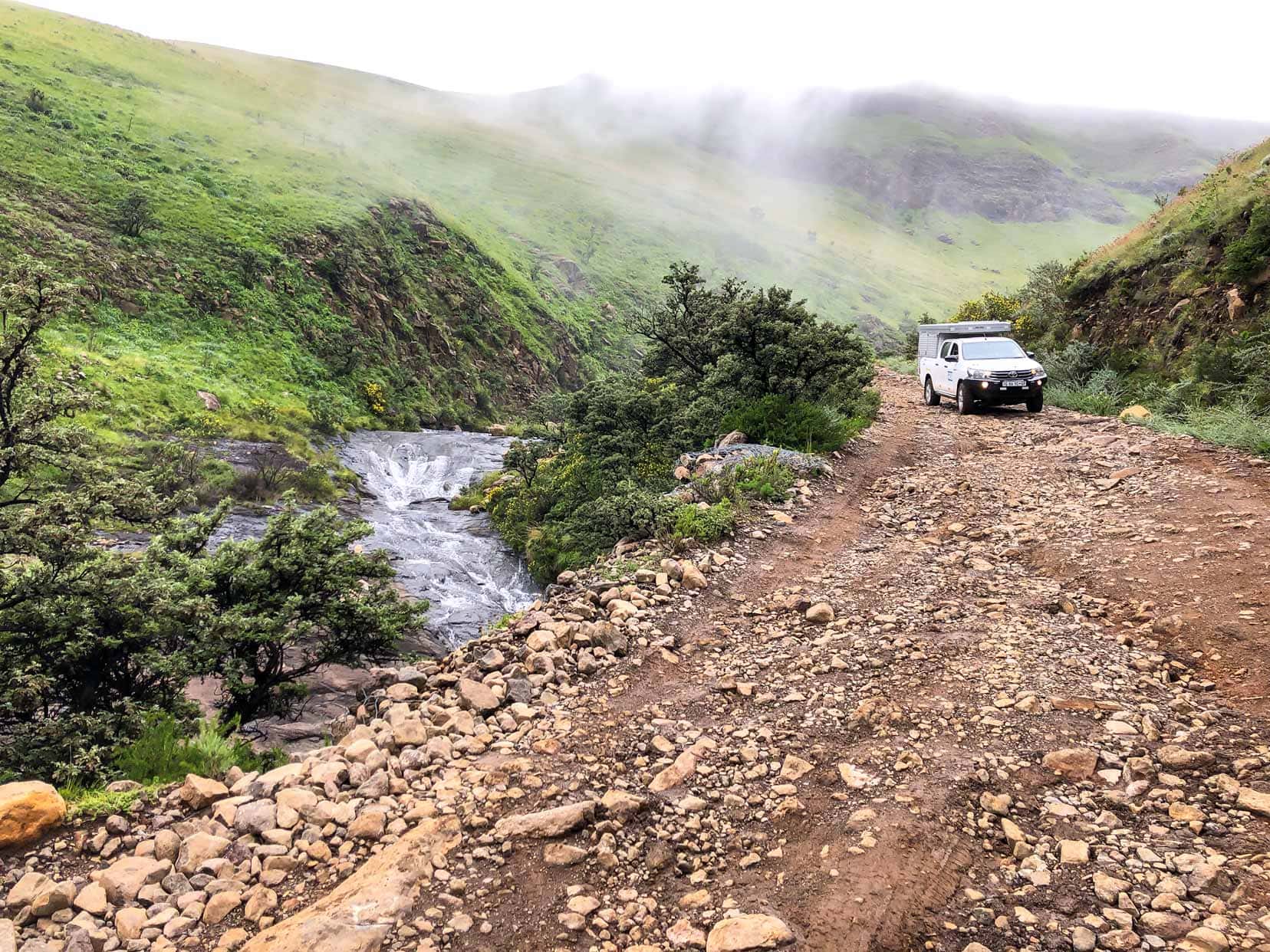
With a last couple of muddy stretches behind us, we arrived at the Sani Pass South African border control point. With passports stamped, we re-entered South Africa to continue our overlanding.
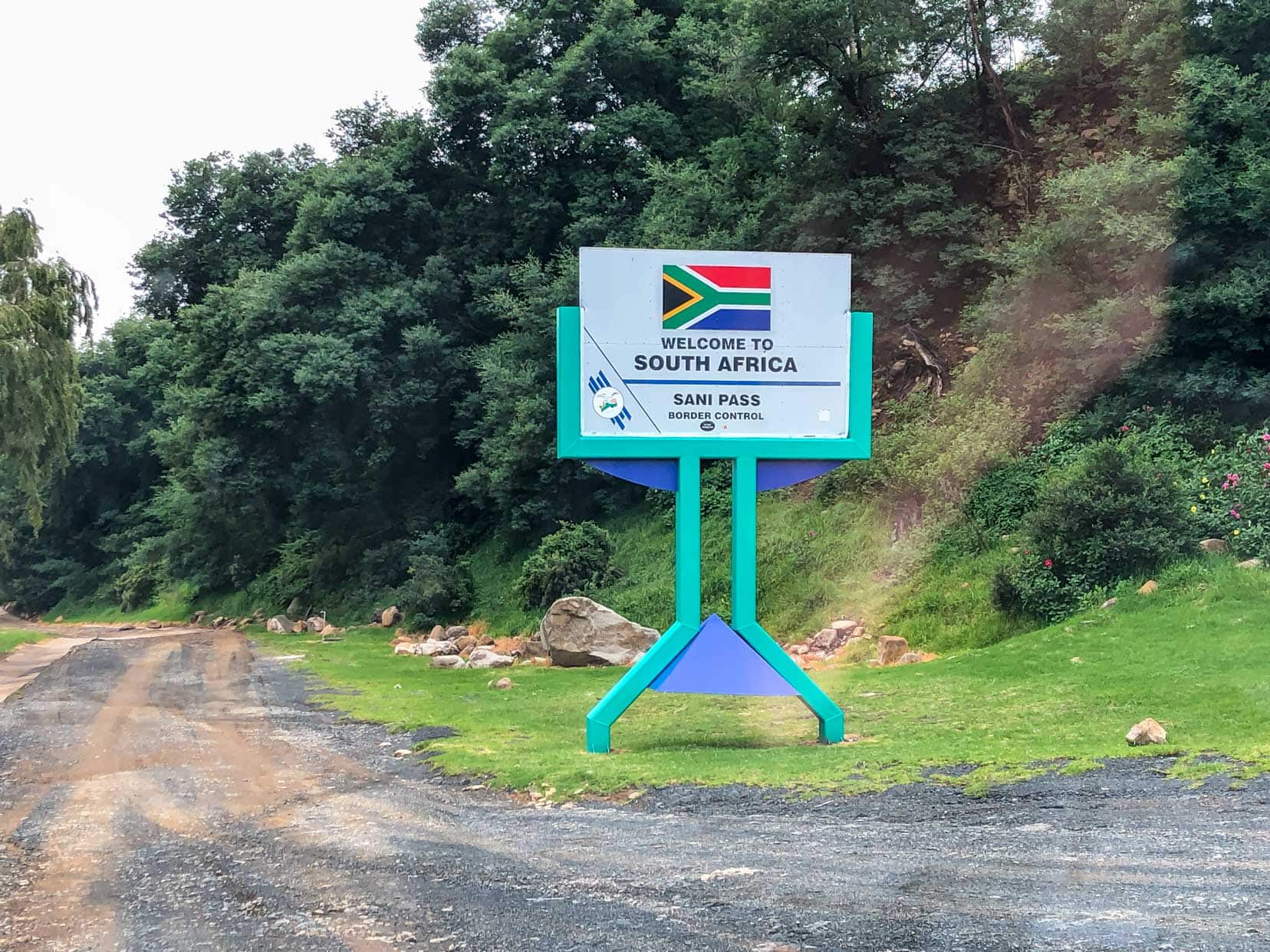
Final Thoughts – Driving this Sani Pass
The descent of the Sani Pass took us 1hr 40 minutes without stops or mishaps. With the weather closing in we didn’t want to be caught on the pass.
The drive itself is not technically difficult. Drive your 4×4 vehicle to suit the conditions. The steepest parts of the Sani Pass at the summit should be driven with care and in 4×4 Low.
Factors that may increase the possibility of a bad Sani Pass driving experience are:
- Driving in heavy rain, fog or snowy conditions
- The driver has minimal 4×4 experience
- The driver is not familiar with the 4×4 vehicle
- Tyres are sub-standard
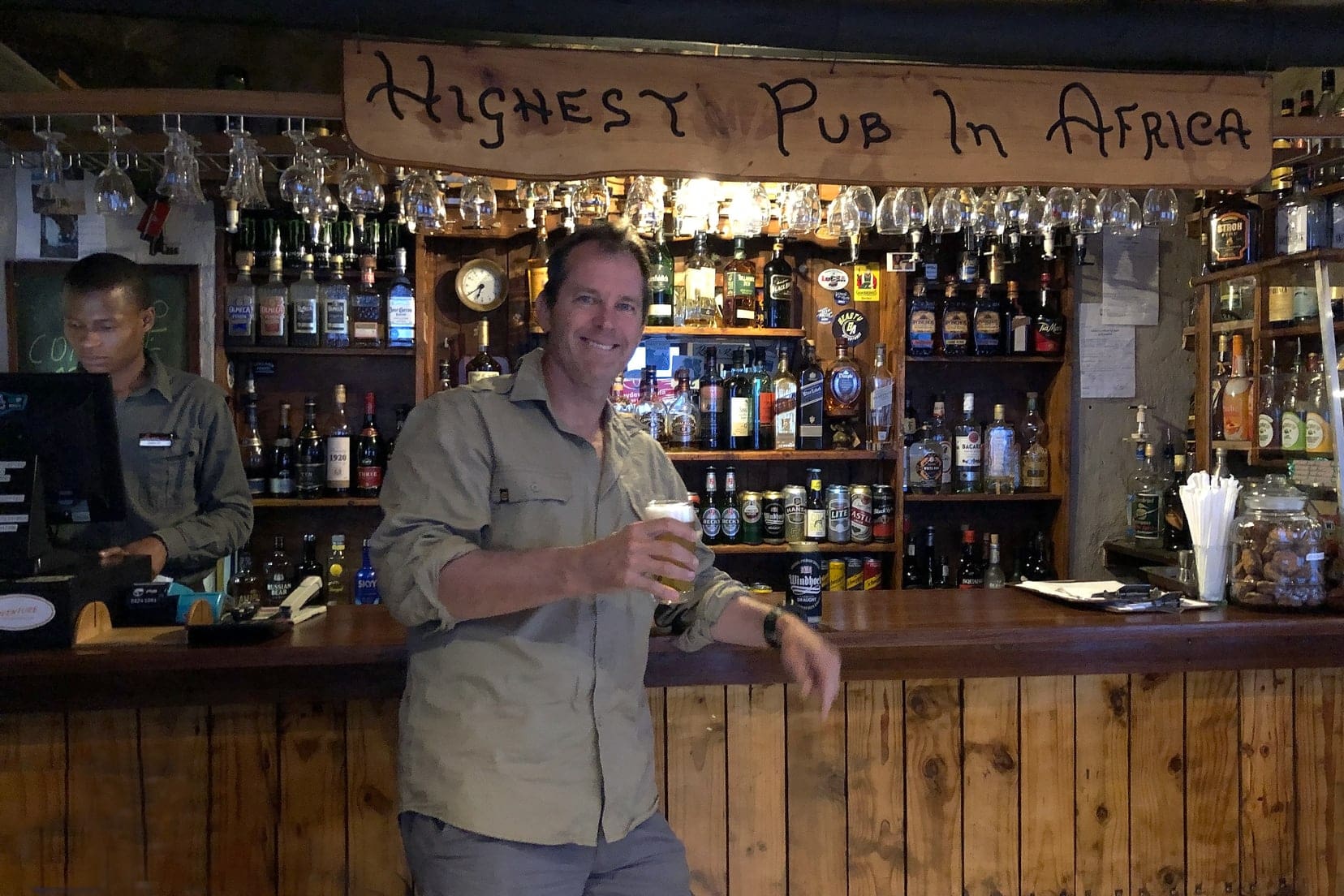
FAQs: Sani Pass 4×4 Drive
1. How Long is the Sani Pass Drive?
The Sani Pass drive is an 8-kilometre gravel road that descends the Drakensberg Mountains between Lesotho and South Africa.
2. Do I Need a 4×4 to Drive the Sani Pass?
Yes, absolutely. The Sani Pass drive requires a 4×4 to drive it. Border control officials may also decide not to let you begin the drive if they deem your vehicle unfit to handle the conditions.
3. How Difficult is the Sani Pass?
Driving the Sani Pass 4×4 road requires some 4×4 experience however, when either the road or the weather deteriorates, driving can become treacherous. Monitoring the weather forecast will help plan your trip to avoid such periods.
4. Can You Walk the Sani Pass?
Yes, it’s possible to walk the Sani Pass by following the road. From other people’s accounts, it is an arduous hike with high winds during the trek.
5. Why is the Sani Pass a Tourist Attraction?
The Sani Pass is a tourist attraction because the gravel road is an iconic 4×4 drive through the beautiful Drakensberg Mountains. The highest Pub in Africa is at the Sani Pass summit. The Sani Pass is between Lesotho and South Africa.
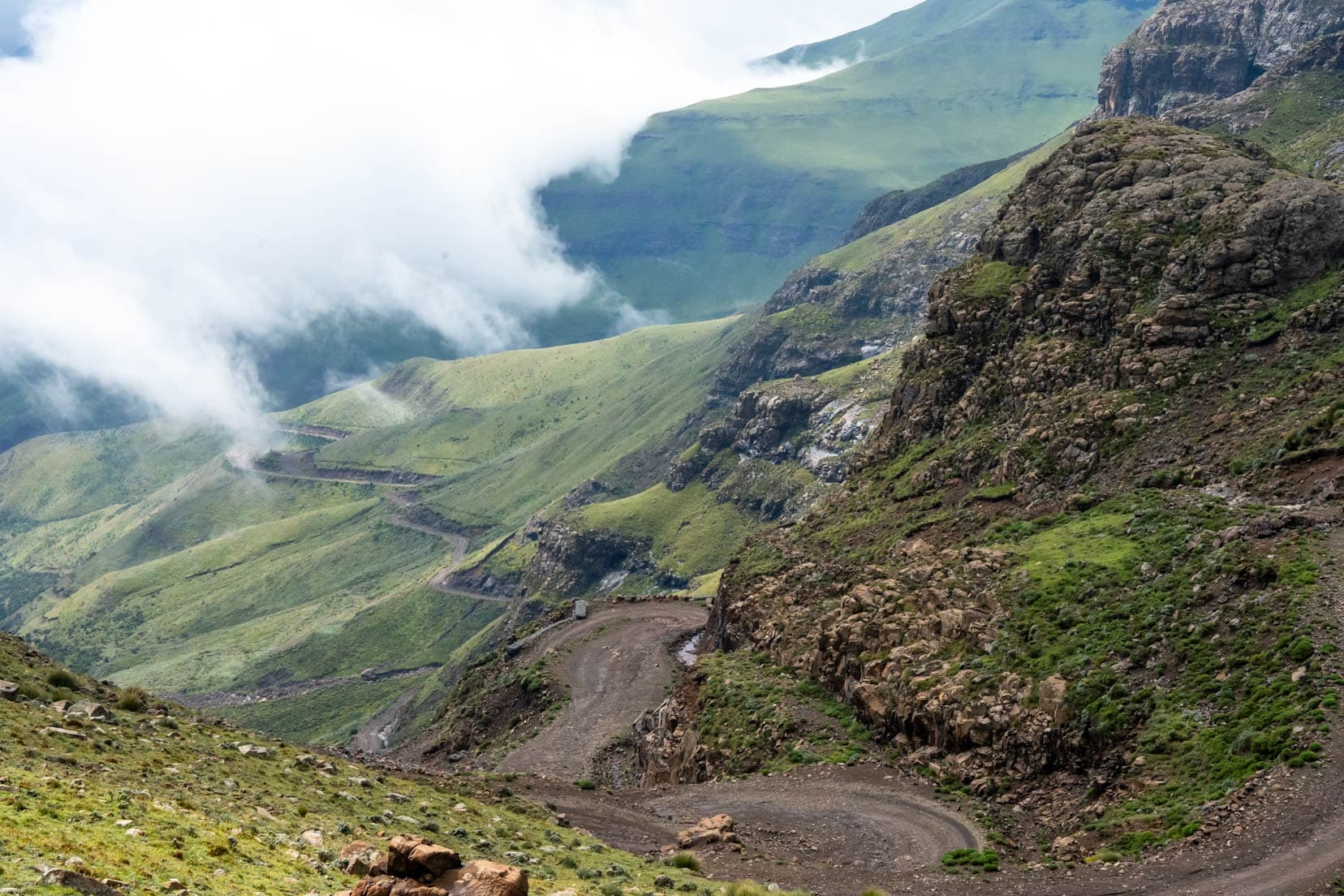
Driving the Sani Pass South Africa … That’s A Wrap
Driving the Sani Pass, one of Africa’s iconic 4×4 drives, is a thrilling test of skill and nerve, offering an unforgettable adventure through breathtaking mountain scenery. It’s a testament to the rugged beauty and challenge of South Africa’s landscapes.
Whether you opt for a self-drive adventure in a 4×4 or a guided tour, this adventure offers a mix of adrenaline and awe-inspiring views, making it a must-experience route for any visitor to the Sani Pass.
I thoroughly enjoyed our self-drive and have now ticked it off my Africa bucket list. I hope you get to enjoy the Sani Pass drive and experience all its wonders.
Go well.
Have you driven the Sani Pass before? Is it on your list of places to visit? We’d love to hear about your experiences and plans.
Pin and Save for Later
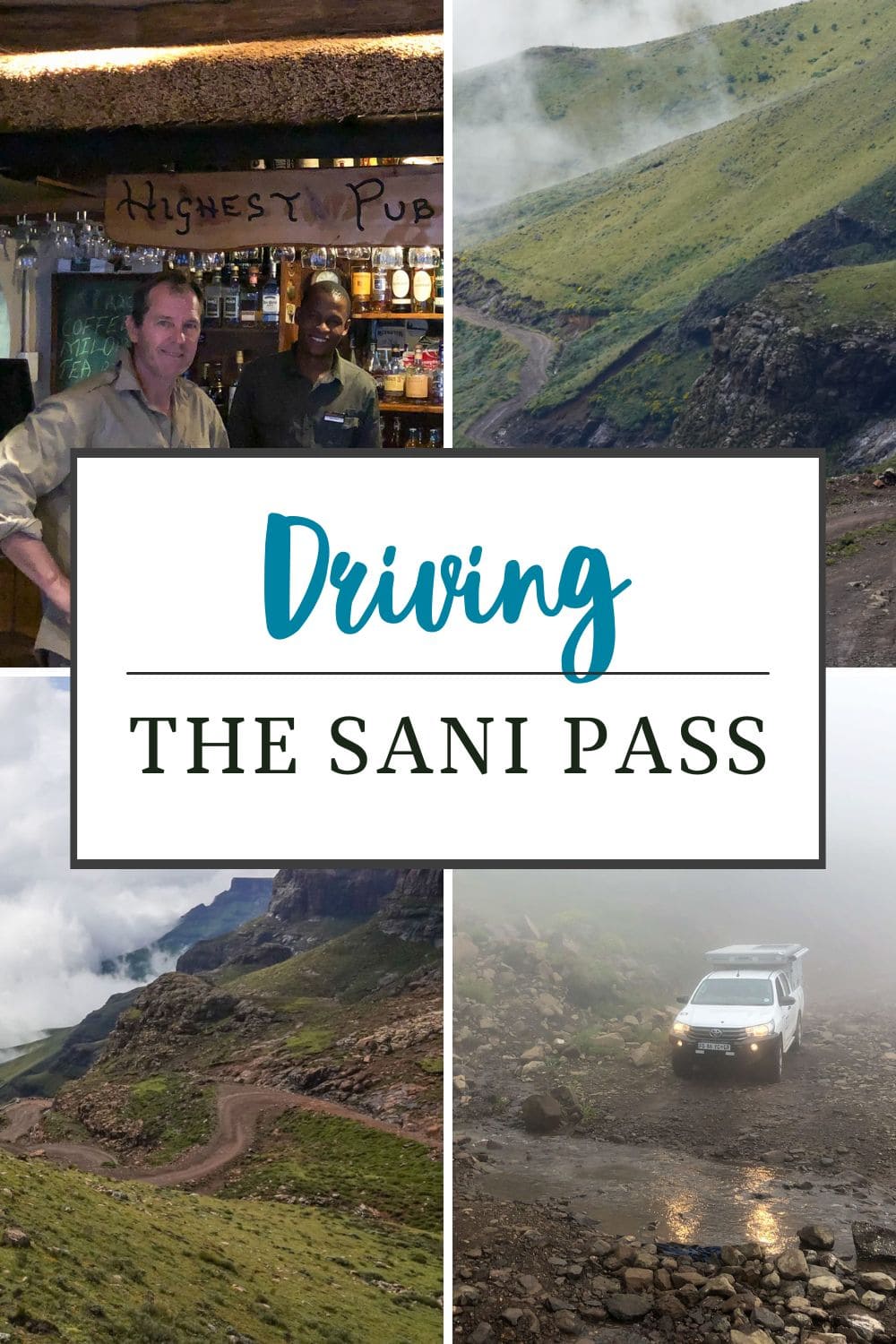
YOU MAY ALSO BE INTERESTED IN READING
- Kruger National Park Self-Drive Safari
- Rhino and Lion Nature Reserve – Safari in the Suburbs
- Driving in South Africa: The Definitive Guide
Planning Your Travels?
These are the travel resources we recommend and use when planning our trips.
- 🚘 Car Hire: We use DiscoverCars.com
- Motorhome/Campervan Rental: We highly recommend the Motorhome Republic
- 🪪 Order your International Driver’s Licence online here
- 🛏 Book Accommodation: We use Booking.com to find accommodation that suits our budget
- 🐶 Pet Sitting/Pet Sitters: Check Out TrustedHousesitters here (Use our Discount code: LIFEJOURNEY25 for 25% off. )
- Activities and Experiences: Get Your Guide and Viator
- Travel Insurance: Safetywing or World Nomads
- 🥾 Travel Gear and Accessories: Check out our top picks here — Lifejourney4two page on Amazon
For a more thorough list, visit our Travel Resources page here.

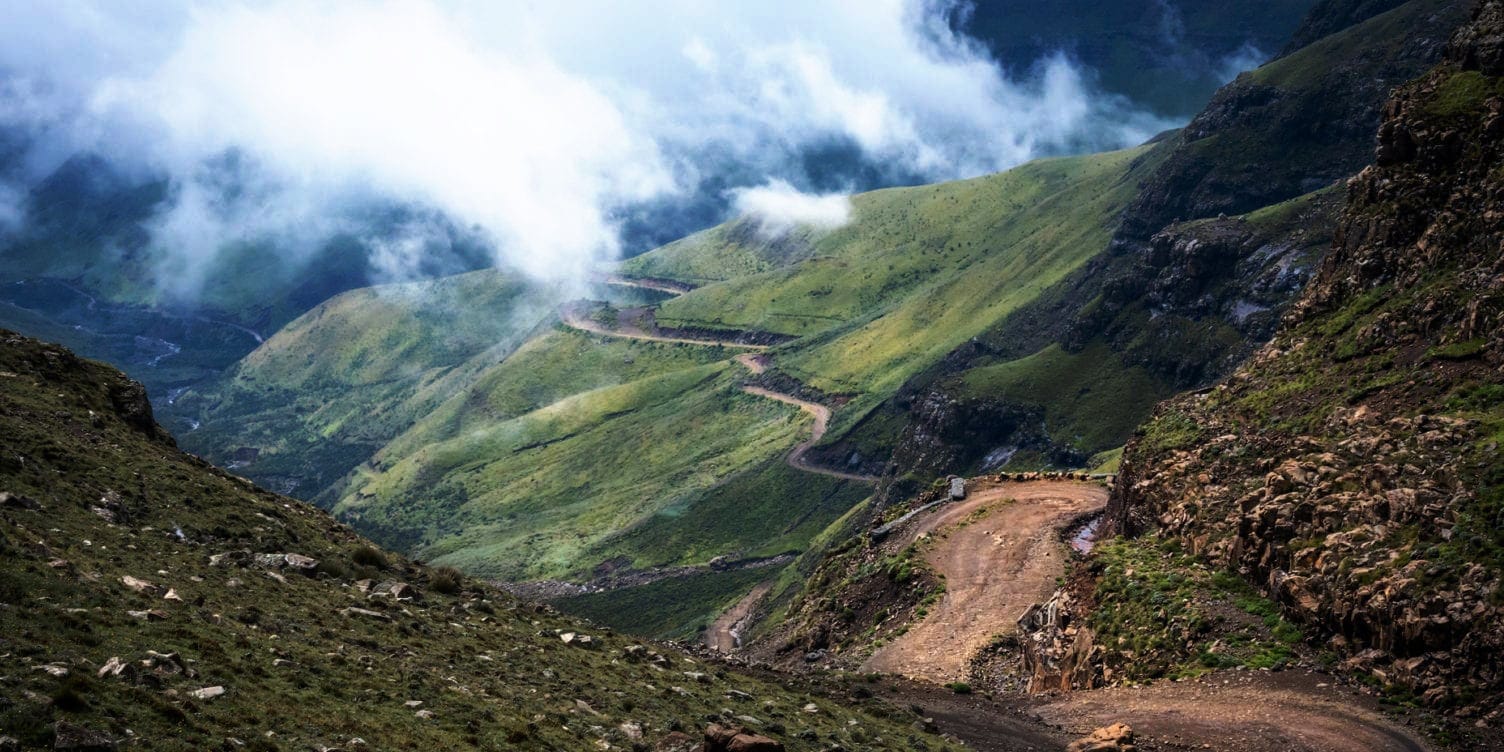
Enjoyed your article Lars
Brought back wonderful memories.
My wife and I drove our restored 1965 Land Rover from London to Cape Town, 14000 miles in 14 months 1/98 to 3/99. Parked in our garage right now in Monroe, North Carolina. Sani Pass was certainly one of the highlights of the trip.
Hi Peter,
Wow, now that’s what I call a trip. What memories! Maybe there’s a book hiding in there? Sani Pass is sure an iconic drive and one everyone well remembers. Thanks for sharing and maybe there’s one more trip in that old Land Rover? Lars
I’ve driven the pass probably 10 times, usually to take overseas visitors. On varying surface conditions! In winter it quite often snows and ice can be a problem! I had a ‘slip and slide’ experience once which was scarier for the passengers than for me! It happened to be filmed by hikers!
Hi Stanton, Sounds like you have more experience than most drivers and I think that anyone that gets to experience the Sani Pass will walk away with a story or two. Slipping and sliding on that road must surely get the pulse rate up! Keep Well, Lars.